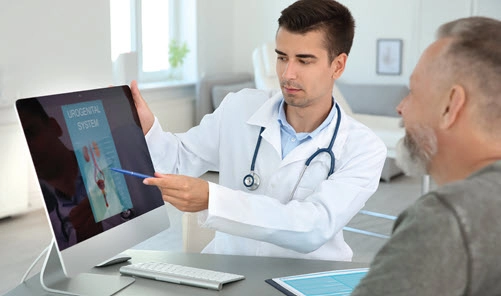Code 51725 is the only simple CMG test option.
When your urologist performs urodynamic testing, they are determining if the patient’s bladder is functioning properly. You must always check the medical documentation to see if your urologist performed a simple or a complex test. You should also double-check if they performed additional tests along with the urodynamics.
Master these three steps to always submit clean urodynamics claims in your urology practice.

Step 1: Break Down What Happens During Urodynamic Testing
Urodynamic studies are investigative procedures used to assess a patient’s bladder function and determine what might be causing them problems. At an initial urodynamic study, your urologist will use a cystometer to measure the patient’s bladder capacity and bladder pressures. The actual test is called a cystometrogram (CMG).
During urodynamic testing, your urologist will insert a catheter into the patient’s bladder through the urethra, and it is necessary for the bladder to be filled with water. The catheter is usually attached to a computer program that calculates the fluid in the bladder to test for the following conditions:
- Frequent urination
- Inability to hold urine
- Involuntary loss of urine
- Slow urination
- Incomplete emptying
Step 2: Focus on CPT® Codes for Urodynamics
CPT® gives you multiple codes to choose from when reporting a CMG and urodynamic studies. Knowing the differences between the tests is your key to proper code choice. When your urologist performs urodynamics tests, you must dig deeper into the documentation for clues about which code to report. Your code choices are as follows:
- 51725 (Simple cystometrogram (CMG) (eg, spinal manometer)) — “Code 51725 is the only choice for a simple CMG,” says Michael A. Ferragamo, MD, FACS, clinical assistant professor of urology, State University of New York, Stony Brook. “A simple CMG uses a spinal manometer to determine bladder pressures and is rarely performed as a single procedure.”
- 51726 (Complex cystometrogram (ie, calibrated electronic equipment)) — A 51726 service is a complex CMG where a urologist will fill the patient’s bladder through a catheter and measure the pressures with complex CMG calibrated electronic equipment.
- 51727 (… with urethral pressure profile studies (ie, urethral closure pressure profile), any technique) — If your provider also performs a complex CMG, fills the patient’s bladder through a catheter, measures the pressures with complex CMG calibrated electronic equipment, and performs a urethral pressure profile (UPP), you should report 51727. Also, you should bill 51727 for a complex CMG and a valsalva leak point pressure (VLPP) in place of a UPP, Ferragamo adds.
- 51728 (... with voiding pressure studies (ie, bladder voiding pressure), any technique) — When your urologist performs a complex CMG with voiding pressure studies using any technique, you should report 51728.
- 51729 (... with voiding pressure studies (ie, bladder voiding pressure) and urethral pressure profile studies (ie, urethral closure pressure profile), any technique) — When your urologist performs a complex CMG with voiding pressure studies and UPP using any technique or VLPP, you should report 51729.

Step 3: Don’t Forget Additional Studies Urologist Performs
When your urologist performs a urodynamic study, they will usually add/perform complex uroflowmetry, which tells your urologist the actual flow of urine on voiding and whether the flow is free or obstructed. You should report uroflowmetry with code 51741 (Complex uroflowmetry (eg, calibrated electronic equipment)).
During a complete urodynamic study, your urologist may also add/perform an electromyography (EMG) with a bladder voiding pressure (VP) study. You may report one or more of the following codes for these studies, if your urologist performs them:
- 51784 (Electromyography studies (EMG) of anal or urethral sphincter, other than needle, any technique) or 51785 (Needle electromyography studies (EMG) of anal or urethral sphincter, any technique)
- +51797 (Voiding pressure studies, intra-abdominal (ie, rectal, gastric, intraperitoneal) (List separately in addition to code for primary procedure)). Note: You can only report add-on code +51797 in conjunction with codes 51728 and 51729. Add-on codes do not require modifier 51 (Multiple procedures), and their fees are not reduced when billed.
- 51798 (Measurement of post-voiding residual urine and/or bladder capacity by ultrasound, non-imaging)
If your urologist performs a radiological voiding study in addition to a complex urodynamics study, you may also report the following codes:
- 51600 (Injection procedure for cystography or voiding urethrocystography)
- 74455 (Urethrocystography, voiding, radiological supervision and interpretation) .


